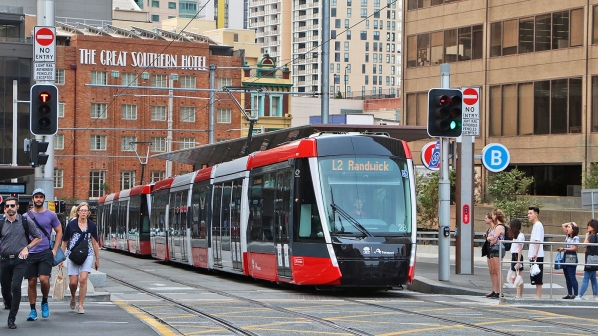THE 1960s marked Australia’s manufacturing heyday. The industry was thriving and made up an impressive 28% of the country’s GDP. In rail, there was a steady flow of locally built rolling stock, and a thriving workforce committed to improving the sector on Australian soil.
Fast forward 60 years and Australia’s rail and wider manufacturing prowess has dwindled. Manufacturing now makes up just 6% of total GDP.
The decline in manufacturing output over the past half-century is a familiar story among many developed markets. The broad consensus in Australia today is that it is quicker and cheaper to outsource rail manufacturing to places like China. And while there is an element of truth in the argument, for countries like Australia, the approach undermines the local industry’s ability to develop and grow at a time when domestic economic support has never been more essential.
As governments across the globe face Covid-19 headwinds, they are seeking ways to create much needed economic stability. The pandemic has shone a light on public sector spending in areas such as infrastructure and manufacturing, with commentators here in Australia rightly asking, “why can’t we build our trains here?”
The short answer is we can. But if Australia is committed to re-establishing and sustaining a prosperous rail manufacturing industry, short-term initiatives for economic survival must be replaced with long-term strategies for revival.
Australia’s state governments are showing signs of agreeing that the rail manufacturing industry is worthy of rejuvenation. Just recently, the Queensland government promised that if returned to power at the upcoming state election, they will invest $A 1bn ($US 730.9m) to create a rail manufacturing work pipeline in regional Queensland, adding 690 new jobs to the local industry.
This announcement is a good starting point that shows commitment to growing the industry in Queensland over the long-term. However, other states must follow suit, planning beyond short-term requirements towards a 30-year-plus manufacturing strategy. Failure to do so will mean public sector investment continues to go offshore, ultimately weakening sovereign capabilities.
But how do you turn the tide?

The power of lean thinking and continuous improvement
There’s no doubt there are efficiency gains that can be made to reduce the costs involved in manufacturing trains locally – thereby deterring governments from outsourcing the work to other countries.
But to achieve maximum efficiency and be cost-competitive on a global stage, it’s essential to look at the industry through a ‘lean principles lens.’ Governments must show commitment to supporting the industry by adopting a long-term philosophy that isn’t just focussed on operational improvement but harnesses lean principles and a culture of continuous improvement that will underpin the industry for decades to come.
Some of the essential factors involved in this approach include:
- Manufacturing facility investment: currently, the short-term approach to manufacturing rolling stock involves repurposing old facilities to support immediate project requirements. However, the industry should instead make long-term strategic investments into state-of-the-art manufacturing facilities that can become manufacturing centres of excellence. These facilities could be state-owned but occupied by the service providers on a contract-to-contract basis.
- Creating healthy competition: governments need to implement a procurement framework that diversifies the end-to-end supply chain by involving multiple companies. Long-term, such competition is vital in encouraging workforce development, innovation and productivity improvement.
- Industry-wide collaboration: while developing an end-to-end supply chain, commercial incentives should be introduced to promote collaboration and knowledge-sharing across the industry. One way to drive this is to set strict targets around collaboration activities that encourage teamwork – commercially rewarding those suppliers that meet or exceed objectives.
- Design for manufacture: moving away from a project approach to a long-term focus on developing larger fleets on a single platform with a periodic update creates significant opportunity to leverage design for manufacture principles. Although this approach requires more engineering investment, it will provide a substantial return on investment over the long-term.
The automotive industry has demonstrated the profound impact of this approach. In just 17-18 hours, companies like Toyota can completely manufacture a car. This astounding performance comes through investment in meticulous design, engineering and planning, plus a commitment to continuous improvement over many decades.
- People and process: developing a strong workforce of highly skilled people is also critical to success. To maximise efficiency, suppliers need to implement the same level of standardised manufacturing processes utilised in the automotive industry. By establishing precise procedures, strict quality controls, and robust performance management systems, units can be manufactured safely and efficiently to meet exacting specifications.
On the production line, workflow and process design, just-in-time material flow, visualisation of production targets and progress are essential. Similarly, forums for regular team communication and resolution of production-related problems need to be established. Team members all need to understand what needs to be done and when, so everyone is fully aligned. Any deviation from the plan or standard needs to be transparent so it can be immediately analysed and resolved. When it comes to manufacturing efficiency, every second counts.
- Performance culture: with baseline design and standardised manufacturing processes established, the foundations are in place to foster continuous improvement. By setting and effectively communicating appropriate performance measures and objectives, a level of accountability is formed. By visibly monitoring progress against these goals, any under-performance can be quickly highlighted and addressed. This relentless measurement and transparency encourages positive behaviour, which, over time, develops a culture of continuous improvement.
Making these changes won’t happen overnight, and it requires substantial investment and determination to do it correctly. However, by taking a longer-term approach, setting industry-wide objectives that can be measured, and adopting a shared purpose across the industry, will lay the foundations for success.
Ross Sterland is a director of Orbiz. Sterland is a highly experienced management consultant and company director specialising in the leadership of operational turnaround and lean transformation programmess across the Asia Pacific region. Sterland has diversified industry expertise across manufacturing, rail, construction, mining, aviation, defence and healthcare.

